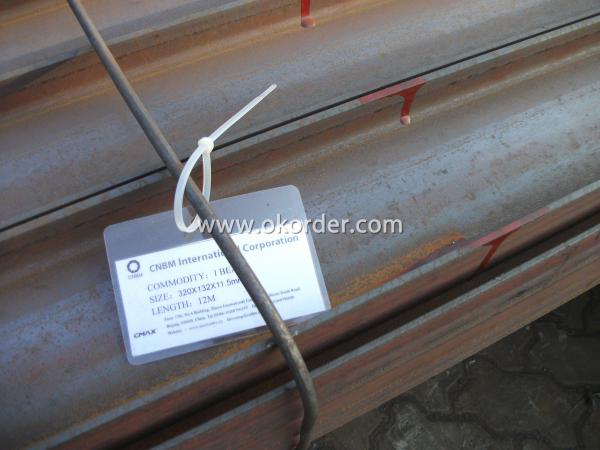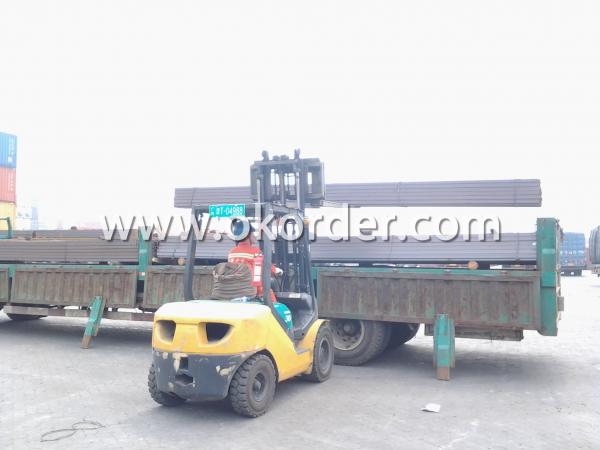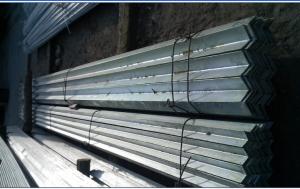Steel I-Beam
- Loading Port:
- Tianjin Port, China
- Payment Terms:
- TT or L/C
- Min Order Qty:
- 25MT m.t.
- Supply Capability:
- 500MT Per Day m.t./month
OKorder Service Pledge
OKorder Financial Service
You Might Also Like
Specifications of Steel I-Beam
Production Standard: GB Standard, EN10025, DIN, JIS, etc.
Material of Steel I-Beam: Q235,SS400,A36,ST37-2,S235JR
Length: 5.8M, 6M, 9M, 12M or as the requriements of the clients
Sizes: 80MM-270MM
Section | Standard Sectional Dimensions(mm) | ||||
| h | b | s | t | Mass Kg/m |
IPE80 | 80 | 46 | 3.80 | 5.20 | 6.00 |
IPE100 | 100 | 55 | 4.10 | 5.70 | 8.10 |
IPE120 | 120 | 64 | 4.80 | 6.30 | 10.40 |
IPE140 | 140 | 73 | 4.70 | 6.90 | 12.90 |
IPE160 | 160 | 82 | 5.00 | 7.40 | 15.80 |
IPE180 | 180 | 91 | 5.30 | 8.00 | 18.80 |
IPE200 | 200 | 100 | 5.60 | 8.50 | 22.40 |
IPE220 | 220 | 110 | 5.90 | 9.20 | 26.20 |
IPE240 | 240 | 120 | 6.20 | 9.80 | 30.70 |
IPE270 | 270 | 135 | 6.60 | 10.20 | 36.10 |
IPEAA80 | 80 | 46 | 3.20 | 4.20 | 4.95 |
IPEAA100 | 100 | 55 | 3.60 | 4.50 | 6.72 |
IPEAA120 | 120 | 64 | 3.80 | 4.80 | 8.36 |
IPEAA140 | 140 | 73 | 3.80 | 5.20 | 10.05 |
IPEAA160 | 160 | 82 | 4.00 | 5.60 | 12.31 |
IPEAA180 | 180 | 91 | 4.30 | 6.50 | 15.40 |
IPEAA200 | 200 | 100 | 4.50 | 6.70 | 17.95 |
Usages of Steel I-Beam
According to the needs of different structures, steel I-beam can compose to different force support component, and also can be the connections between components. They are widely used in various building structures and engineering structures such as roof beams, bridges, transmission towers, hoisting machinery and transport machinery, ships, industrial furnaces, reaction tower, container frame and warehouse etc.
Packaging & Delivery of Steel I-Beam
1. Packing: it is nude packed in bundles by steel wire rod
2. Bundle weight: not more than 3.5MT for bulk vessel; less than 3 MT for container load
3. Marks:
Color marking: There will be color marking on both end of the bundle for the cargo delivered by bulk vessel. That makes it easily to distinguish at the destination port.
Tag mark: there will be tag mark tied up on the bundles. The information usually including supplier logo and name, product name, made in China, shipping marks and other information request by the customer.
If loading by container the marking is not needed, but we will prepare it as customer request.

4. Transportation: the goods are delivered by truck from mill to loading port, the maximum quantity can be loaded is around 40MTs by each truck. If the order quantity cannot reach the full truck loaded, the transportation cost per ton will be little higher than full load.

5. Delivered by container or bulk vessel


6. Delivery time: All the structural steel I beams will be at the port of the shipment within 45 days after receiving the L/C at sight ot the advance pyment.
7. Payment: L/C at sight; 30% advance payment before production, 70% before shipment by T/T, etc.
Production flow of Steel I-Beam
Material prepare (billet) —heat up—rough rolling—precision rolling—cooling—packing—storage and transportation
- Q:How are steel I-beams installed in construction projects?
- Steel I-beams are commonly used in construction projects due to their strength and stability. The installation process of steel I-beams involves several steps. Firstly, the structural engineer determines the appropriate size and length of the I-beam required for the specific project. The I-beams are then ordered from a manufacturer based on these specifications. Once the I-beams are delivered to the construction site, a crane is typically used to lift and position them into place. A crew of skilled workers, including ironworkers, riggers, and crane operators, work together to carefully maneuver the I-beam into position. In many cases, the I-beams are bolted or welded to the supporting columns or foundation. This ensures a secure and stable connection. The use of high-strength bolts or welding techniques depends on the specific design and requirements of the project. Before the final installation, the I-beams are aligned and leveled to ensure they are in the correct position. This is crucial for the overall structural integrity of the building. During the installation process, safety measures are of utmost importance. Workers wear protective gear and follow strict safety protocols to prevent accidents and injuries. In summary, steel I-beams are installed in construction projects through a combination of careful planning, skilled labor, and the use of cranes. The beams are typically bolted or welded to the supporting structure to ensure a strong and stable connection. Safety measures are always prioritized to ensure a successful and secure installation process.
- Q:Can steel I-beams be used in schools or educational facilities?
- Schools and educational facilities can indeed utilize steel I-beams. These beams are widely employed in the construction industry because of their robustness, endurance, and adaptability. By lending structural support to buildings, they prove to be ideal for educational establishments where safety takes precedence. Steel I-beams exhibit remarkable resistance to heavy loads and provide the necessary stability, making them invaluable in schools featuring multiple floors and expansive areas. Moreover, their utilization allows for greater flexibility in design, as they can span longer distances without requiring supplementary support columns, thereby creating open and commodious learning environments. All in all, steel I-beams represent a dependable and pragmatic choice for construction within schools and educational facilities.
- Q:Can steel I-beams be used for earthquake-prone regions?
- Indeed, earthquake-prone regions can utilize steel I-beams. Steel, being a remarkably ductile material, exhibits exceptional resistance against seismic forces. Specifically, I-beams are renowned for their structural integrity and capability to endure lateral forces generated by earthquakes. The high strength-to-weight ratio of steel I-beams renders them suitable for constructing buildings that can withstand earthquakes. By flexing and absorbing energy during seismic events, these I-beams effectively dissipate the forces acting on the structure, thereby minimizing damage. Furthermore, steel I-beams can be designed and engineered in accordance with specific seismic requirements, guaranteeing the safety of those occupying the building. Nonetheless, it is crucial to emphasize that proper design, construction, and adherence to seismic building codes are imperative to ensure the effectiveness of steel I-beams in earthquake-prone regions.
- Q:Are steel I-beams susceptible to corrosion?
- Yes, steel I-beams are susceptible to corrosion.
- Q:Can Steel I-Beams be used for educational institutions like schools or universities?
- Educational institutions like schools or universities can indeed utilize steel I-beams. Construction commonly employs steel I-beams due to their notable attributes of strength, durability, and versatility. They offer exceptional structural support, which renders them suitable for the construction of expansive and unencumbered areas such as classrooms, auditoriums, gymnasiums, and libraries. Moreover, steel I-beams can withstand substantial loads, ensuring stability and the safety of both the edifice and its occupants. Additionally, steel stands as an environmentally friendly choice for sustainability-conscious educational institutions, as it boasts a high recycling rate. In conclusion, steel I-beams serve as a dependable and pragmatic solution for erecting educational structures.
- Q:What is the maximum span length for a steel I-beam?
- The maximum span length for a steel I-beam depends on various factors such as the size and shape of the beam, the type of steel used, and the load it is expected to support. Generally, steel I-beams can span a considerable distance due to their structural strength and load-bearing capacity. However, it is essential to consult with a structural engineer or a professional in the field to determine the specific maximum span length for a particular steel I-beam, as it will vary based on the specific project requirements and building codes.
- Q:What are the maintenance requirements for steel I-beams in corrosive environments?
- In corrosive environments, steel I-beams require regular inspection, cleaning, and protective coatings to prevent corrosion. This includes removing any built-up debris or rust, applying anti-corrosive paints or coatings, and ensuring proper drainage to prevent water accumulation. Additionally, frequent monitoring and prompt repair of any damaged or deteriorated areas are essential to maintain the structural integrity and longevity of the steel I-beams in corrosive environments.
- Q:Are there any building code requirements specific to steel I-beams?
- Yes, there are building code requirements specific to steel I-beams. These requirements are in place to ensure the structural integrity and safety of buildings that utilize steel I-beams as load-bearing members. Some of the common building code requirements include: 1. Sizing and design criteria: Building codes specify the minimum size and design criteria for steel I-beams based on factors such as the span of the beam, load requirements, and the specific application. These criteria ensure that the I-beams can support the intended loads without excessive deflection or failure. 2. Material specifications: Building codes often specify the type and quality of steel that should be used for I-beams. The material should have the necessary strength, ductility, and other properties to withstand the expected loads and environmental conditions. 3. Connection requirements: Building codes provide guidelines for the connection of steel I-beams to other structural elements or components. These requirements ensure that the connections are strong enough to transfer the loads effectively and safely. 4. Fire protection: Steel I-beams are susceptible to high temperatures during fires, which can weaken their structural integrity. Building codes may require fire protection measures such as fireproofing materials or the use of intumescent coatings to enhance the fire resistance of steel I-beams. 5. Inspection and testing: Building codes often stipulate the requirements for inspection and testing of steel I-beams during construction to ensure compliance with the specified standards. This may include visual inspections, non-destructive testing, or load testing to verify the quality and performance of the I-beams. It is important for architects, engineers, and contractors to adhere to these building code requirements when using steel I-beams in construction projects to ensure the safety and compliance of the structures.
- Q:How do steel I-beams perform in high-moisture areas?
- Steel I-beams generally perform well in high-moisture areas, provided they are properly protected against corrosion. Steel is a durable and strong material that can withstand high moisture conditions, such as those found in coastal regions or areas prone to high humidity or moisture levels. However, if exposed to moisture without suitable protection, steel I-beams can be susceptible to rust and corrosion, which can weaken their structural integrity over time. To ensure optimal performance in high-moisture areas, it is crucial to implement proper corrosion prevention measures. This typically involves applying protective coatings or paints to the surface of the steel I-beams. These coatings act as a barrier against moisture, preventing direct contact between the steel and the surrounding environment. Additionally, regular inspections and maintenance should be conducted to identify and address any signs of corrosion or damage promptly. It is worth noting that in extremely corrosive environments, such as those with high salt content or chemical exposure, additional measures may be required. In these cases, stainless steel or galvanized steel I-beams are often recommended, as they offer enhanced resistance against corrosion. Stainless steel contains chromium, which forms a passive oxide layer that provides excellent protection against moisture and corrosion. Galvanized steel, on the other hand, is coated with a layer of zinc that acts as a sacrificial barrier, preventing the steel from coming into contact with moisture. In summary, steel I-beams can perform well in high-moisture areas if properly protected against corrosion. By implementing appropriate preventive measures, such as coatings, regular maintenance, and, if necessary, using stainless steel or galvanized steel, the structural integrity and longevity of the I-beams can be preserved even in challenging moisture-rich environments.
- Q:How do steel I-beams perform in terms of sustainability?
- Steel I-beams are highly sustainable due to their durability, recyclability, and energy efficiency. They have a long lifespan, require minimal maintenance, and can be recycled at the end of their use. Furthermore, steel production processes have become more environmentally friendly, reducing emissions and energy consumption. As a result, steel I-beams are an excellent choice for sustainable construction and infrastructure projects.
1. Manufacturer Overview |
|
|---|---|
| Location | Qinhuangdao, China |
| Year Established | 2000 |
| Annual Output Value | Above US$ 300 Million |
| Main Markets | Mid East; Africa; Southeast Asia; Brazil |
| Company Certifications | ISO 9001:2008; |
2. Manufacturer Certificates |
|
|---|---|
| a) Certification Name | |
| Range | |
| Reference | |
| Validity Period | |
3. Manufacturer Capability |
|
|---|---|
| a)Trade Capacity | |
| Nearest Port | Tianjin; |
| Export Percentage | 70% - 80% |
| No.of Employees in Trade Department | 21-50 People |
| Language Spoken: | English; Chinese; |
| b)Factory Information | |
| Factory Size: | Above 400,000 square meters |
| No. of Production Lines | 2 |
| Contract Manufacturing | OEM Service Offered; |
| Product Price Range | Average |
Send your message to us
Steel I-Beam
- Loading Port:
- Tianjin Port, China
- Payment Terms:
- TT or L/C
- Min Order Qty:
- 25MT m.t.
- Supply Capability:
- 500MT Per Day m.t./month
OKorder Service Pledge
OKorder Financial Service
Similar products
New products
Hot products
Hot Searches
Related keywords




























